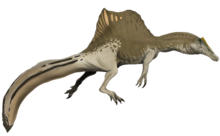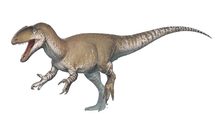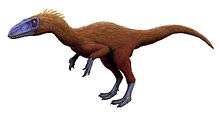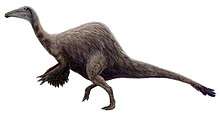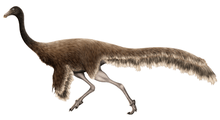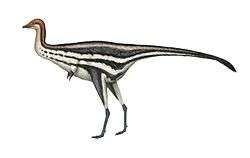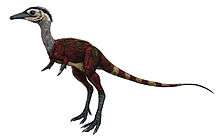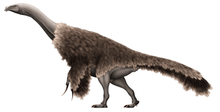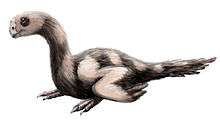Pennaraptora
Pennaraptora (Latin penna "bird feather" + raptor "thief", from rapere "snatch"; a feathered bird-like predator) is a clade defined as the most recent common ancestor of Oviraptor philoceratops, Deinonychus antirrhopus, and Passer domesticus (the house sparrow), and all descendants thereof, by Foth et al., 2014.[1] The earliest known definitive member of this clade is Anchiornis, from the late Jurassic period of China, about 160 million years ago.
| Pennaraptorans | |
|---|---|
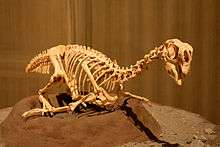 | |
| Cast skeleton of Conchoraptor gracilis | |
.jpg) | |
| House sparrow (Passer domesticus) | |
| Scientific classification | |
| Kingdom: | Animalia |
| Phylum: | Chordata |
| Clade: | Dinosauria |
| Clade: | Saurischia |
| Clade: | Theropoda |
| Clade: | Maniraptoriformes |
| Clade: | Maniraptora |
| Clade: | Pennaraptora Foth et al., 2014 |
| Subgroups | |
The clade "Aviremigia" was conditionally proposed along with several other apomorphy-based clades relating to birds by Jacques Gauthier and Kevin de Queiroz in a 2001 paper. Their proposed definition for the group was "the clade stemming from the first panavian with ... remiges and rectrices, that is, enlarged, stiff-shafted, closed-vaned (= barbules bearing hooked distal pennulae), pennaceous feathers arising from the distal forelimbs and tail".[2]
References
- Foth, Christian (2014). "New specimen of Archaeopteryx provides insights into the evolution of pennaceous feathers". Nature. 511 (7507): 79–82. doi:10.1038/nature13467. PMID 24990749.
- Gauthier, J. and de Queiroz, K. (2001). "Feathered dinosaurs, flying dinosaurs, crown dinosaurs, and the name 'Aves'". Pp. 7-41 in Gauthier, J. and L.F. Gall (eds.), New Perspectives on the Origin and Early Evolution of Birds: Proceedings of the International Symposium in Honor of John H. Ostrom. New Haven: Peabody Museum of Natural History, Yale University. ISBN 0-912532-57-2.



